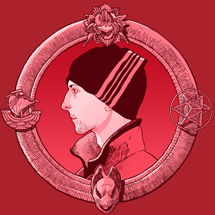This section will soon feature fan art and pin-ups. Till then, please enjoy some…
TRIVIA
Find out fun facts and anecdotes about the making of ANIMUS:ANIMUS was originally titled TOOTHLESS, then THE PLAYGROUND.
Antoine originally drew all of ANIMUS's pages in the traditional reading direction of manga/Asian comics (upper-right to bottom-left), then mirrored the sketches and drew the story so that it is read in the Western direction. A lot of attention had to be given to the fact that one of the lead characters, Hisao, is left-handed.
What's in a name? ANIMUS's lead character Sayuri's name means "Small Lily" (from the Japanese 小 (sa) = "small" and 百合 (yuri) = "lily"), a tribute to Antoine's chihuahua, Lily, who also makes a cameo appearance in the book's epilogue. This also follows in the tradition of Indiana Jones taking on his pet dog's name.
The first name of the other lead character, Hisao, means "old boy." This is both a premonition of the boy's destiny and the first name of filmmaker Akira Kurosawa's son (Katsuhiro Ôtomo titled his famed manga Akira as an homage to the film director, and naming this character after his child follows in this tradition).
The cat Mamba is inspired by the Revoys' pet cat, Mama. Her name in the graphic novel is a nod to her black color ("black mamba"), Hisao's fear of snakes, and is also short for "Yamamba" (a Japanese witch).
Antoine's three nephews and two nieces make cameo appearances in ANIMUS. One of them wears his favorite team's jersey (football team Paris-Saint-Germain) in every photograph, one of them likes to read comics on the train, one of them likes to play with Rubik's Cubes, one of them listens attentively in class, and the last one is so young that she rides in a stroller.
The playground in ANIMUS is inspired by the real-life playground where Antoine used to play (and daydream) in the 1980s with his siblings, in their childhood neighborhood—Ebisu, in Tokyo's Shibuya district. This original playground exists to this day.
Antoine and his wife travelled on several occasions to the Kyoto sites seen in the book. They did not encounter any ghosts.
The final art of ANIMUS was produced over the course of 16 months of drawing circa 10 hours daily.
Given the trivia above, Antoine believes that the retail price of ANIMUS is good value for money.
When inking the finished pages of ANIMUS, Antoine listened to, among many other things, every single episode of the podcasts You Must Remember This Podcast—the murder of Sharon Tate episode was pretty bleak!—as well as his favorite podcasts at the time, the Bret Easton Ellis Podcast and The History of Byzantium. All of this drove Antoine's wife crazy.
Antoine had several music albums and songs in mind to inspire the mood and atmosphere of ANIMUS, mainly Erik Satie's Gymnopédies and Gnossiennes. Try listening to those while reading ANIMUS!
Other soundtracks for work on ANIMUS included—New Order's Technique, U2's Zooropa, Aphex Twin's Richard D. James Album and Alberto Balsalm, The Postal Service's only album, Interpol's first two albums, The Blue Hearts compilations, all of David Bowie's music, Susumu Hirasawa's original soundtrack for the feature animation PAPRIKA, and the Sega CD soundtrack of the videogame SNATCHER. Couldn't have done it without them!
The book ANIMUS was supposed to open with the following quote, by Jorge Luis Borges:
“When writers die they become books, which is, after all, not too bad an incarnation.”
However, Antoine forgot to run it by his editor one last time before going to press. Woops! *This quote was added to the books's special edition.
However, Antoine forgot to run it by his editor one last time before going to press. Woops! *This quote was added to the books's special edition.
SPOILERS
Learn some of ANIMUS's deepest secrets, by selecting (= highlighting) text in the boxes below:In Chapter 8's dream sequence, Hisao encounters a multitude of other masked ghosts. These spirits, like Toothless, are tsukumogami, and some of their names are Faceless, Hairless, Skinless, Headless and Nameless.










